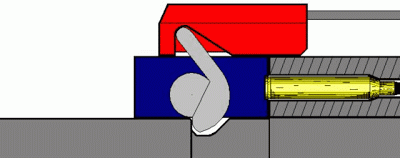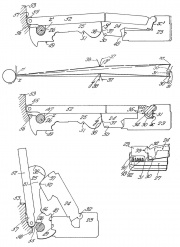Blowback
Blowback is an operating system for autoloading firearms that utilizes energy created by combustion in the chamber and bore acting directly on the bolt face through the cartridge. Other operating systems are recoil operation, gas-operation, Gatling, and chain.
Contents |
[edit] Principle
In a blowback mechanism, the mass of the bolt and force of the recoil spring act to keep the breech closed as the cartridge is fired. Expanding gases from the fired round overcome this inertia and "blow back" the breech. The breech is kept sealed by the cartridge case until the bullet has left the barrel and gas pressure drops to a safe level; the weight of the bolt and spring pressure ensure this. To remain practical, this system is only suitable for weapons using relatively low pressure rounds. Pure blowback operation is typically found on semi-automatic small-caliber pistols and automatic submachine guns. Some low-velocity cannon or grenade launchers such as the Mk 19 grenade launcher use blowback operation.
[edit] Delayed blowback systems
For more powerful rounds and for a lighter operating mechanism, some system of delayed or retarded blowback is often used, requiring the bolt to overcome some initial resistance while moving. Because of high pressures, delayed blowback firearms, such as the G3 rifle, have fluted chambers to ease extraction. There are various delay mechanisms:
[edit] Roller delayed
Heckler & Koch refined roller-delayed blowback operation from the distinctly different roller-locked recoil operation as seen in the MG42. Unlike the MG42, in roller-delayed blowback the barrel is fixed and does not recoil. As the bolt head is driven rearward, rollers on the sides of the bolt are driven inward against a tapered bolt carrier extension. This forces the bolt carrier rearward at a much greater velocity and slows movement of the bolt. The primary advantage of roller-delayed blowback is the simplicity of the design compared to gas or recoil operation.[1]
Roller-delayed blowback was first used in the experimental MG 42 derivative MG42V and the 1945 Mauser Sturmgewehr 45 prototype. The first full-scale production rifle to utilize roller-delay was the Spanish CETME. Modern examples are the Heckler & Koch G3 rifle, MP5 submachine gun, and P9 pistol as well as the Sturmgewehr 57.
[edit] Lever delayed
Lever-delayed blowback utilizes leverage to delay the opening of the breech. When the cartridge pushes against the bolt face, the lever moves the bolt carrier rearward at an accelerated rate relative to the light bolt. This leverage significantly increases resistance and slows the movement of the lightweight bolt. The mechanism was invented by Hungarian arms designer Pál Király (a.k.a. Paul de Kiraly) in the 1930s and first used in the Danuvia 43M submachine gun. Other weapons to use this system are the San Cristobal .30 carbine, the FAMAS[2], the Benelli B76 and the AA-52 machine gun.[edit] Gas delayed
Gas-delayed blowback should not be confused with gas-operated. The bolt is never locked, and so is pushed rearward by the expanding propellant gases as in other blowback-based designs. However, propellant gases are vented from the barrel into a cylinder with a piston that delays the opening of the bolt. It is used by Volkssturmgewehr 1-5 rifle, the Heckler & Koch P7 and Steyr GB pistols.
[edit] Chamber-ring delayed
When a cartridge is fired, the case expands to seal the sides of the chamber. This seal prevents high-pressure gas from escaping into the action of the gun. Because a conventional chamber is slightly oversized, an unfired cartridge will enter freely. In a chamber-ring delayed firearm, the chamber is conventional in every respect except for a raised portion at the rear of smaller diameter than the front of the chamber. When the case expands in the front of the chamber and pushes rearward on the slide, it is slowed as this raised portion constricts the expanded portion of the case as the case is extracted. The Seecamp pistol operates on this principle.
[edit] Hesitation locked
John Pedersen's patented system uses a separate breech block within the slide or bolt carrier. When in battery, the breech block rests slightly forward of the locking shoulder in the frame. When the cartridge is fired, the bolt and slide move together a short distance rearward powered by the energy of the cartridge as in a standard blowback system. When the breech block contacts the locking shoulder, it stops, locking the breech in place. The slide continues rearward with the momentum it acquired in the initial phase. This allows chamber pressure to drop to safe levels while the breech is locked and the cartridge slightly extracted. Once the bullet leaves the barrel and pressure drops, the continuing motion of the slide lifts the breech block from its locking recess through a cam arrangement, continuing the firing cycle. The Remington 51 was the only production firearm to utilize this type of operating system.
[edit] Toggle delayed
In toggle-delayed blowback firearms, the rearward motion of the breechblock must overcome significant mechanical leverage.[4] The bolt is hinged in the middle and stationary at the rear end. The hinge is nearly straight. As the breech moves back under blowback power, the hinge joint moves upward. The leverage advantage keeps the breech from opening until the bullet has left the barrel and pressures have dropped to a safe level. This mechanism was utilized on the Pedersen rifle and Schwarzlose MG M.07/12 machine gun. [5] Modern high-pressure blowback systems such as the HK G3 and FAMAS utilize fluted chambers to facilitate extraction. Lacking fluted chambers, both of these rifles required cases lubricated with wax (Pedersen) or oil (Schwarzlose).
[edit] Other blowback systems
[edit] Floating chamber
Famous designer "Carbine" Williams (also credited with designing the M1 Carbine) developed a mechanism to allow full-sized firearms to fire .22 caliber rimfire ammunition reliably. His system utilized a small 'piston' that incorporates the chamber. When the cartridge is fired, the front of the piston is thrust back with the cartridge giving a significant push to the bolt. Often described as accelerated blowback, this amplifies the otherwise anemic recoil energy of the .22 caliber cartridge.[6] The Colt Ace conversion kit and modern versions utilize this system.
[edit] API blowback
Advanced Primer Ignition (API) was developed by Reinhold Becker [7] for use on open bolt submachine guns. The cartridge is discharged as the bolt is still moving forward. This means that the blowback energy has to reverse the forwards momentum of the bolt to push it rearward. This serves multiple functions including reducing recoil, decreasing the mass required for the bolt, and reducing the movement of the sights due to the bolt slamming home.
[edit] Primer actuated
Primer actuated firearms utilize blowback force to set the primer back. As the primer is pushed out of the case, it operates a mechanism to unlock and cycle the firearm. John Garand was the first to develop the system in an unsuccessful bid to replace the M1903 bolt action rifle although another of his designs was eventually accepted. AAI Corporation used their developmental piston primer mechanism in a rifle submitted for the Advanced Combat Rifle competition.[8]
[edit] Limited-utility designs
[edit] Blish lock
- main article: Blish lock
The Blish Lock is a breech locking mechanism designed by John Bell Blish based upon his observation that under extreme pressures, certain dissimilar metals will resist movement with a force greater than normal friction laws would predict. In modern engineering terminology, it is called static friction, or stiction. His locking mechanism was used in the Thompson submachine gun for a short time, but this dubious principle was later eliminated as redundant. Any actual advantage could also be attained by adding a mere ounce of mass to the bolt.
[edit] Savage rotating barrel
The Savage system theorized that the rifling in the barrel caused a rotational force that would hold the gun locked until the projectile left the barrel. It was later discovered that the bullet had left the barrel long before any locking could occur; Savage pistols merely operated on a pure blowback basis.
[edit] References
- ↑ Stevens, R. Blake, Full Circle: A Treatise on Roller Locking, Collector Grade Publications (2006). ISBN 0889354006.
- ↑ Modern firearms - GIAT FAMAS assault rifle (France) world.guns.ru article
- ↑ US Patent 1,737,974
- ↑ Cliff Carlisle, Japanese Pedersen Semi Auto Rifles & Carbines, www.carbinesforcollectors.com article
- ↑ Hatcher, Julian, Hatcher's Notebook, The Military Service Press Company (1947), pp. 38-44. ISBN 0-8117-0795-4.
- ↑ Charles E. Petty, Delightful diversion: testing Kimber's new rimfine was a tough job, but someone had to do it, Guns Magazine, March, 2004. Contains some discussion about the floating chamber device.
- ↑ Williams, Anthony G., Of Oerlikons and other things…… www.quarry.nildram.co.uk article
- ↑ Flirting With Flechettes: The US Army's Search for the Ideal Rifle Projectile Cruffler.com May 2000 article
- Bremner, Derek, The MG42V and the Origins of Delayed Blowback Roller Lock: WWII German Equipment (Paperback). ISBN 0-9533792-0-5.
[edit] External links
- Blowback action, Animation and explanation at howstuffworks.com
- HKPro HKPro page explaining the principle, albeit using the "roller-locking" terminology
- Heckler and Koch USA now uses the "roller-delayed blowback" terminology

